Environmental Engineering Reference
In-Depth Information
0.35
0.30
a
sh
= 0.1
b
sh
= 0.27
0.25
0.20
0.15
0.10
0.05
0
0
10
20
30
40
50
60
70
80
Gravimetric water content, %
Figure 2.24
Effect of varying
c
sh
parameter on shrinkage curve equation (from M.D. Fredlund
et al., 2002a).
of published test results (M.D. Fredlund et al., 2002a). The
average value for the
c
sh
parameter for
undisturbed
soil speci-
mens was 9.57 with a standard deviation of
experimentally. The
c
sh
parameter provides the general cur-
vature for the shrinkage curve. The variation in the shrinkage
curve produced by varying the
c
sh
parameter is quite mini-
mal and as such it is possible to obtain an estimate of the
shrinkage curve.
9
.
3. The average
value for the
c
sh
parameter for initially slurry soil specimens
was 25.3 with a standard deviation of
±
25
.
4. The average
value for the
c
sh
parameter for
compacted
soil specimens
was 8.47 with a standard deviation of
±
3
.
6.
Approximate values for the minimum void ratio or
a
sh
equation parameter have been presented by Holtz and
Kovacs (1981) and are shown in Fig. 2.25. The data allow
the shrinkage limit to be estimated and converted to an
equivalent void ratio when the plastic limit of the soil is
known. Data in Fig. 2.25 provide a means of estimating
the
a
sh
shrinkage curve parameter.
The estimation procedure described provides an approxi-
mate shape for the shrinkage curve. However, it is preferable
to measure the entire shrinkage curve in the laboratory. The
largest variation in the shrinkage curve occurs as a result
of estimating the minimum void ratio,
a
sh
, of the soil. It is
relatively easy to measure the minimum void ratio of a soil
±
2.2.4.3 Calculation of Void Ratio versus Soil Suction
The SWCC describes the relationship between the water
content of a soil and soil suction. The volume change occur-
ring when drying a clayey soil can be substantial and is
relevant to the interpretation of SWCC data. Figure 2.26
shows SWCC data for highly plastic Black clay (Dagg et al.,
1967). It is possible to determine the void ratio-soil suction
relationship when the volume changes are known during the
drying process (i.e., from the shrinkage curve). The volume
changes can be estimated through the use of the shrink-
age curve. The shrinkage curve for the Black clay is shown
in Fig. 2.27. Figure 2.28 shows the void ratio-soil suction
constitutive relationship computed from the SWCC and the
70
Undisturbed
Compacted
Sturried remolded
Remolded
60
SL = 0.356PI + 15.3
(undisturbed samples)
50
Undisturbed
40
30
SL = 0.291PI + 11.4
(remolded samples)
20
10
SL = 0.159PI + 11.9
v (compacted samples)
0
0
20
40
60
80
100
120
Plastic limit
Figure 2.25
Relationship between shrinkage limit and plastic limit for variety of soils (after
Holtz and Kovacs, 1981).


























Search WWH ::

Custom Search